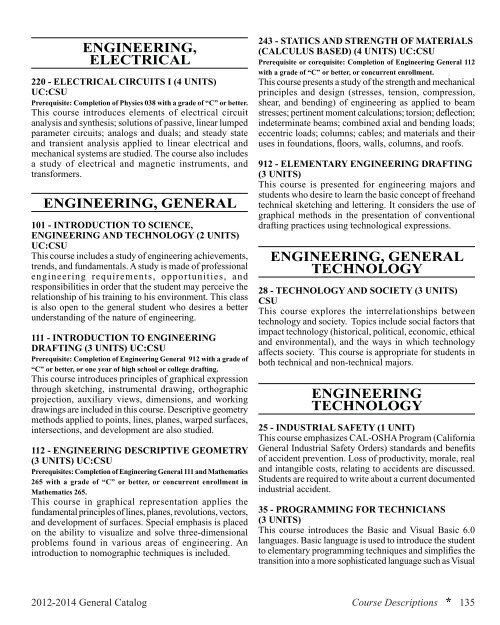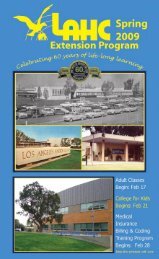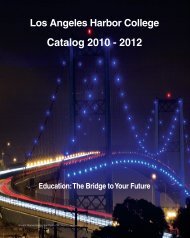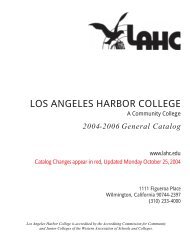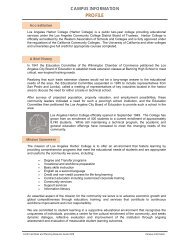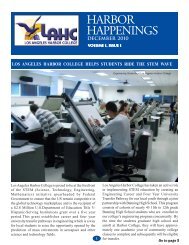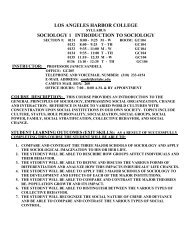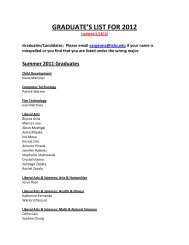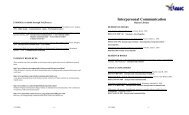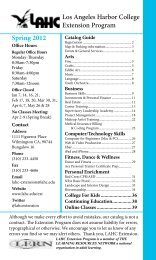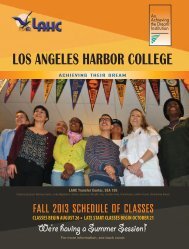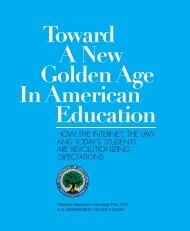Download File - Los Angeles Harbor College
Download File - Los Angeles Harbor College
Download File - Los Angeles Harbor College
You also want an ePaper? Increase the reach of your titles
YUMPU automatically turns print PDFs into web optimized ePapers that Google loves.
ENGINEERING,<br />
ELECTRICAL<br />
220 - ELECTRICAL CIRCUITS I (4 UNITS)<br />
UC:CSU<br />
Prerequisite: Completion of Physics 038 with a grade of “C” or better.<br />
This course introduces elements of electrical circuit<br />
analysis and synthesis; solutions of passive, linear lumped<br />
parameter circuits; analogs and duals; and steady state<br />
and transient analysis applied to linear electrical and<br />
mechanical systems are studied. The course also includes<br />
a study of electrical and magnetic instruments, and<br />
transformers.<br />
ENGINEERING, GENERAL<br />
101 - INTRODUCTION TO SCIENCE,<br />
ENGINEERING AND TECHNOLOGY (2 UNITS)<br />
UC:CSU<br />
This course includes a study of engineering achievements,<br />
trends, and fundamentals. A study is made of professional<br />
engineering requirements, opportunities, and<br />
responsibilities in order that the student may perceive the<br />
relationship of his training to his environment. This class<br />
is also open to the general student who desires a better<br />
understanding of the nature of engineering.<br />
111 - INTRODUCTION TO ENGINEERING<br />
DRAFTING (3 UNITS) UC:CSU<br />
Prerequisite: Completion of Engineering General 912 with a grade of<br />
“C” or better, or one year of high school or college drafting.<br />
This course introduces principles of graphical expression<br />
through sketching, instrumental drawing, orthographic<br />
projection, auxiliary views, dimensions, and working<br />
drawings are included in this course. Descriptive geometry<br />
methods applied to points, lines, planes, warped surfaces,<br />
intersections, and development are also studied.<br />
112 - ENGINEERING DESCRIPTIVE GEOMETRY<br />
(3 UNITS) UC:CSU<br />
Prerequisites: Completion of Engineering General 111 and Mathematics<br />
265 with a grade of “C” or better, or concurrent enrollment in<br />
Mathematics 265.<br />
This course in graphical representation applies the<br />
fundamental principles of lines, planes, revolutions, vectors,<br />
and development of surfaces. Special emphasis is placed<br />
on the ability to visualize and solve three-dimensional<br />
problems found in various areas of engineering. An<br />
introduction to nomographic techniques is included.<br />
243 - STATICS AND STRENGTH OF MATERIALS<br />
(CALCULUS BASED) (4 UNITS) UC:CSU<br />
Prerequisite or corequisite: Completion of Engineering General 112<br />
with a grade of “C” or better, or concurrent enrollment.<br />
This course presents a study of the strength and mechanical<br />
principles and design (stresses, tension, compression,<br />
shear, and bending) of engineering as applied to beam<br />
stresses; pertinent moment calculations; torsion; deflection;<br />
indeterminate beams; combined axial and bending loads;<br />
eccentric loads; columns; cables; and materials and their<br />
uses in foundations, floors, walls, columns, and roofs.<br />
912 - ELEMENTARY ENGINEERING DRAFTING<br />
(3 UNITS)<br />
This course is presented for engineering majors and<br />
students who desire to learn the basic concept of freehand<br />
technical sketching and lettering. It considers the use of<br />
graphical methods in the presentation of conventional<br />
drafting practices using technological expressions.<br />
ENGINEERING, GENERAL<br />
TECHNOLOGY<br />
28 - TECHNOLOGY AND SOCIETY (3 UNITS)<br />
CSU<br />
This course explores the interrelationships between<br />
technology and society. Topics include social factors that<br />
impact technology (historical, political, economic, ethical<br />
and environmental), and the ways in which technology<br />
affects society. This course is appropriate for students in<br />
both technical and non-technical majors.<br />
ENGINEERING<br />
TECHNOLOGY<br />
25 - INDUSTRIAL SAFETY (1 UNIT)<br />
This course emphasizes CAL-OSHA Program (California<br />
General Industrial Safety Orders) standards and benefits<br />
of accident prevention. <strong>Los</strong>s of productivity, morale, real<br />
and intangible costs, relating to accidents are discussed.<br />
Students are required to write about a current documented<br />
industrial accident.<br />
35 - PROGRAMMING FOR TECHNICIANS<br />
(3 UNITS)<br />
This course introduces the Basic and Visual Basic 6.0<br />
languages. Basic language is used to introduce the student<br />
to elementary programming techniques and simplifies the<br />
transition into a more sophisticated language such as Visual<br />
2012-2014 General Catalog Course Descriptions * 135


